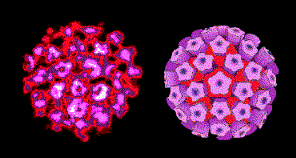

A virus is a noncellular infectious agent with two characteristics. It consists of a nucleic acid core (either DNA or RNA) surrounded by a protein coat. It cannot reproduce itself. It can only be reproduced using a host cell. It can replicate only after its nucleic acid has entered and subverted the host cell's biosynthetic apparatus to produce new viral proteins.
The Adenovirus is a DNA virus that causes colds and "pink eye".
The Papillomavirus is a DNA virus that causes warts.
The Influenza virus causes the flu. It has RNA as its genetic material instead of DNA.
Bacteriophages infect bacterial cells , usually with negative effects on the cell, but they have been invaluable in genetic engineering research.
The steps of viral replication are as follows:
Viral replication can proceed by way of two pathways:
In the lytic pathway, the virus quickly accomplishes the five steps listed above and causes the cell to rupture (lysis), spilling its contents and the viruses.
In lysogenic pathways, the viral genes remain inactive inside the host cell (and its descendants). Often the genes become integrated into the host DNA only to resume their destructive viral activity later.
This animation (Audio - Important) describes the two pathways of viral replication.
AIDS is a combination of disorders that follows infection with HIV. These diseases include yeast (Candida) infections, Pneumocystis pneumonia, and Karposi's sarcoma.
HIV is a RNA retrovirus. A protein at the virus surface binds to receptors on helper T cells, an important component of the immune system. Once bound, RNA and viral enzymes enter the host cell. HIV DNA is called a provirus. It inserts into the host DNA. The host cell makes copies of viral DNA and viral proteins that assemble to form new virus particles. Release of new viral particles kills the host T cell. The body is constantly making new T cells, but cannot outpace the rate of destruction. As infection proceeds, T cell numbers inevitably decline. An infected individual becomes vulnerable to other infections, which eventually result in death.
HIV does not live long outside the human body. It is most often spread by exchange of bodily fluids with an infected person. In the U.S., anal intercourse and needle sharing are main modes of transmission. HIV can also be transmitted by vaginal intercourse and oral sex. HIV can travel from mothers to offspring during pregnancy, birth, or breast-feeding. HIV is not known to be transmitted by food, air, water, casual contact, or insect bites. There is no cure for HIV. Once HIV genes are incorporated, there is no way to get them out. AZT, and other drugs slow the course of the disease and increase the life span. Researchers continue to develop drugs and to work toward an AIDS vaccine.
This animation (Audio - Important) describes HIV replication.
Viroids and Prions
Viroids are smaller than viruses and are tightly folded strands or circles of RNA with no protein coat or protein-coding genes. They cause diseases in plants, including valuable crops. They actually resemble introns (noncoding portions of eukaryotic DNA) or they might be left over from an ancient RNA world.
Prions are small proteins linked to serious human diseases such as Kuru and Creutzzfeldt-Jakob diseases. Prions also cause a disease called Scrapie in sheep and mad cow disease (Bovine spongiform encephalopathy).
REVIEW: Most scientists do not consider viruses to be "alive" because��
REVIEW: �Viroids differ from viruses in that the former lack�
REVIEW: The multiplication cycle of all viruses requires _____ .��
PREVIOUS